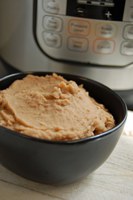Prairie Fare: I’m Spillin’ the Beans
(Click an image below to view a high-resolution image that can be downloaded)
By Julie Garden-Robinson, Food and Nutrition Specialist
NDSU Extension
“Do you need any rice?” I asked with a slightly muffled voice.
I was strolling with my son in a grocery store. Both of us were wearing cloth face masks.
“No, I’m good,” he replied. “I have 50 pounds.”
I think he said 50 pounds, anyway.
He laughed when he saw my wide eyes and raised eyebrows as I glanced in his direction.
“Well, I have a lot of rice,” he responded.
“Do you need some beans to go with your rice?” I asked as we continued strolling down the dry goods aisle.
Rice and beans are complementary proteins, which means that this combination of foods contains all the essential amino acids (protein building blocks).
“I haven’t tried dry beans from a bag, only canned beans,” he noted.
I thought it would be a good experiment for him. However, I was surprised to see an empty shelf where all the dry beans typically were located.
We in nutrition have been encouraging people to eat more beans for years, and it took a pandemic to make it happen. I could say the same thing about handwashing advice.
“I have another idea,” I said as I pushed the cart about 20 feet ahead of us to the Mexican food section. It was well stocked with pinto beans, black beans and other types of beans. We picked up 2 pounds.
Then I did a minilesson on bean use right there in the store. My son seemed to be listening.
At least he was tolerating me because I bought the groceries.
Many people are looking for ways to stretch their food dollars. Beans are rich in a variety of essential nutrients such as protein, fiber, iron, folate, potassium, magnesium and zinc. Beans also contain important cancer-fighting antioxidants.
Beans can be added to soups, casseroles, salads, snacks and desserts.
According to published research, bean consumption may reduce the risk for heart disease and certain types of cancer, such as colon cancer. Additionally, a diet that includes beans is associated with lower body weight and better control of blood sugar among those with diabetes.
For those who have food allergies or follow special diets (such as vegetarian or gluten-free), beans are valuable because they provide nutrients, including fiber, protein, and many vitamins and minerals, that may be missing or low in specialized diets.
If you purchased or received a multifunction pressure cooker (such as an Instant Pot), you might want to try it to make bean recipes. Here are the steps to using dry beans:
Sort 1 pound (2 cups) of dry beans to remove any split beans or small stones that may be in the bag. Rinse. Use one of the following soaking methods. Use filtered water if your water is hard to help soften the beans during soaking. Consider adding some salt to the soaking water to form a brine solution.
- To do the hot soak method: For every 2 cups of dry beans, add 10 cups of hot water in a stockpot. Boil for two to three minutes and allow to soak for up to four hours.
- To do the quick soak method: For every 2 cups of dry beans, add 6 cups of water in a stockpot. Boil for two to three minutes and allow to soak for at least one hour.
- To do the traditional soak: For each 2 cups of dry beans, add 10 cups of water and let soak overnight or for at least eight hours in the refrigerator.
Then drain the soak water, add fresh water and cook the beans until tender, or use a multifunction pressure cooker (such as an Instant Pot or similar appliance) according to the accompanying instructions. Two cups of dry beans equals about 4 1/2 to 5 cups of cooked beans.
You can freeze the cooked beans for future use in recipe-sized amounts. Be sure to label the freezer container with the contents and date.
We can help with your food explorations and budget-stretching. I have two resources to highlight this week:
- “Spillin’ the Beans” is a recipe collection featuring a variety of beans. See https://tinyurl.com/SpillinBeans for details.
- See “Pressure Cook Dry Beans to Save Money and Time” to learn more about recipes to make in a pressure cooker, including Classic Chili and Red Beans and Sausage. See https://tinyurl.com/PressureCookBeans for details.
Here’s a recipe you can make in a multifunction pressure cooker or you can prepare this recipe by simmering on your stove and then mashing.
Refried Beans
16 oz. pinto beans, dry
1 1/2 c. onion, diced
7 c. low-sodium vegetable broth
6 oz. can green chilies, undrained
1 1/2 tsp. seasoned salt
2 Tbsp. apple cider vinegar
1 tsp. Tabasco sauce (or adjust to taste)
Place all ingredients in a pressure cooker and stir until combined. Close the lid and set to high pressure for 60 minutes. Allow pressure to release naturally for 15 minutes, then release the remaining pressure. Remove lid and turn off cooker. Stir mixture and then drain, reserving some liquid for blending. Mash beans, adding liquid as needed to reach desired consistency. Serve immediately.
Makes 16 (1/2-cup) servings. Each serving has 220 calories, 0 grams (g) fat, 12 g protein, 40 g carbohydrate, 5 g fiber and 860 milligrams sodium.
(Julie Garden-Robinson, Ph.D., R.D., L.R.D., is a North Dakota State University Extension food and nutrition specialist and professor in the Department of Health, Nutrition and Exercise Sciences. Follow her on Twitter @jgardenrobinson)
NDSU Agriculture Communication - April 30, 2020
| Source: | Julie Garden-Robinson, 701-231-7187, julie.garden-robinson@ndsu.edu |
|---|---|
| Editor: | Ellen Crawford, 701-231-5391, ellen.crawford@ndsu.edu |




